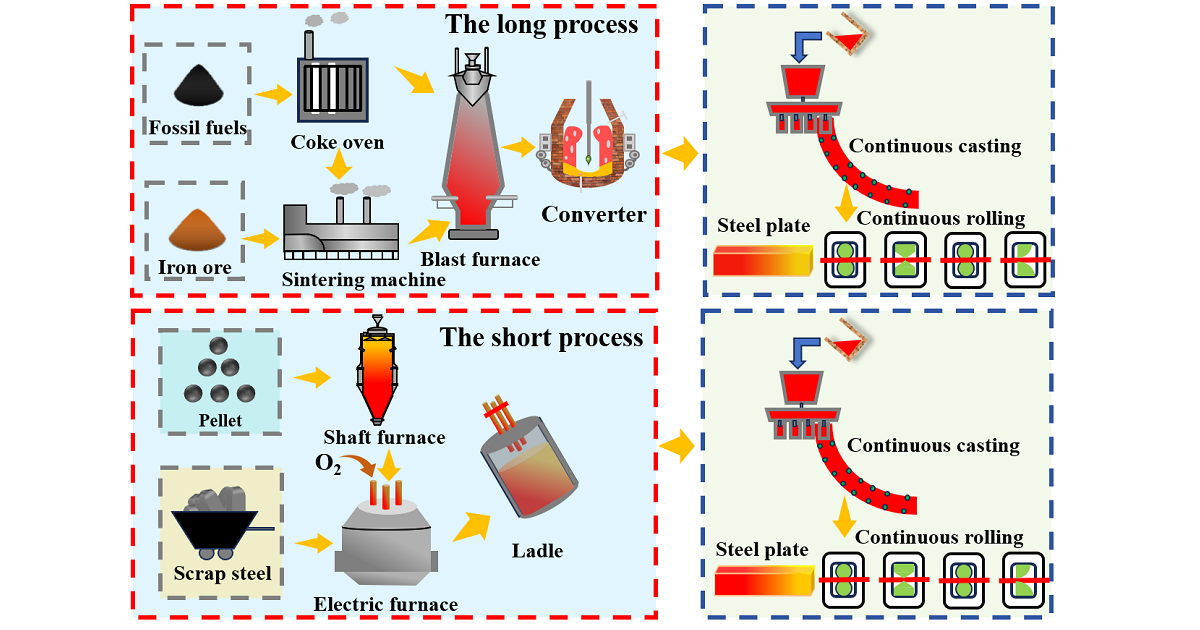Green Metallurgical Process and Technology
A special issue of Processes (ISSN 2227-9717). This special issue belongs to the section "Energy Systems".
Deadline for manuscript submissions: 30 June 2025 | Viewed by 2582

Special Issue Editors
Interests: CO2 resource utilization; low-carbon smelting; high-nitrogen steel; metallurgical slag; waste heat recovery; energy conversion and clean utilization; electric furnace steelmaking
Special Issues, Collections and Topics in MDPI journals
Interests: hydrogen smelting; CO2 resource utilization; energy conversion and clean utilization; hydrogen-rich blast furnace injection; hydrogen base shaft furnace direct reduction; electric furnace steelmaking
Special Issues, Collections and Topics in MDPI journals
Special Issue Information
Dear Colleagues,
Iron and steel are industries with high energy consumption and carbon dioxide emissions, and green manufacturing these processes has become the trend of future development. The process of iron and steel production involves blast–converter and electric arc furnaces. The blast–converter furnace process is also known as the long process, the production of steel is called converter steel. In this process, iron ore and coke as the main raw materials are first smelted into hot metal and then into steel by the converter. On the other hand, the electric arc furnace process is known as the short process. The steel produced is called electric furnace steel, which is smelted into steel with scrap steel as the main raw material. Around 70% of the energy used in the metallurgy process is wasted during the steelmaking process. It is therefore important to master the mechanisms of both the long and short processes in steelmaking and recover the waste heat.
Recent advances in energy recovery and advanced technology for the metallugy process have attracted attention. These include hydrogen smelting, electric furnace steelmaking, and high-nitrogen steel smelting technologies and the recovery of waste heat from metallurgical processes, amongst others. To achieve green metallurgical processes and technology, it is necessary to decrease energy consumption in iron and steel production. This Special Issue is aimed at all researchers and technologists interested in all aspects of the science, technology, and applications of green metallurgy processes and technology. It will feature original research papers and reviews related to hydrogen smelting, electric furnace steelmaking, high-nitrogen steel smelting, and energy recovery. We invite scientists working in the area of renewable energy and green metallurgy technology to contribute to this Special Issue.
“Green Metallurgical Processes and Technology” aims to gather novel advances in reducing energy consumption and CO2 emissions during the metallurgy process. Potential topics include the following:
- Hydrogen, low-carbon, and high-nitrogen smelting technologies;
- CO2 resource utilization;
- Electric furnace steelmaking;
- Recovery of waste heat from metallurgical slag.
Dr. Xin Yao
Dr. Huaqing Xie
Guest Editors
Manuscript Submission Information
Manuscripts should be submitted online at www.mdpi.com by registering and logging in to this website. Once you are registered, click here to go to the submission form. Manuscripts can be submitted until the deadline. All submissions that pass pre-check are peer-reviewed. Accepted papers will be published continuously in the journal (as soon as accepted) and will be listed together on the special issue website. Research articles, review articles as well as short communications are invited. For planned papers, a title and short abstract (about 100 words) can be sent to the Editorial Office for announcement on this website.
Submitted manuscripts should not have been published previously, nor be under consideration for publication elsewhere (except conference proceedings papers). All manuscripts are thoroughly refereed through a single-blind peer-review process. A guide for authors and other relevant information for submission of manuscripts is available on the Instructions for Authors page. Processes is an international peer-reviewed open access monthly journal published by MDPI.
Please visit the Instructions for Authors page before submitting a manuscript. The Article Processing Charge (APC) for publication in this open access journal is 2400 CHF (Swiss Francs). Submitted papers should be well formatted and use good English. Authors may use MDPI's English editing service prior to publication or during author revisions.
Keywords
- hydrogen smelting
- hydrogen-rich blast furnace injection
- hydrogen base shaft furnace direct reduction
- CO2 resource utilization
- low-carbon smelting
- high-nitrogen steel
- metallurgical slag
- waste heat recovery
- energy conversion and clean utilization
- electric furnace steelmaking
Benefits of Publishing in a Special Issue
- Ease of navigation: Grouping papers by topic helps scholars navigate broad scope journals more efficiently.
- Greater discoverability: Special Issues support the reach and impact of scientific research. Articles in Special Issues are more discoverable and cited more frequently.
- Expansion of research network: Special Issues facilitate connections among authors, fostering scientific collaborations.
- External promotion: Articles in Special Issues are often promoted through the journal's social media, increasing their visibility.
- e-Book format: Special Issues with more than 10 articles can be published as dedicated e-books, ensuring wide and rapid dissemination.
Further information on MDPI's Special Issue policies can be found here.






